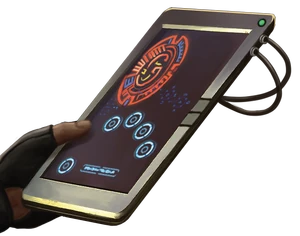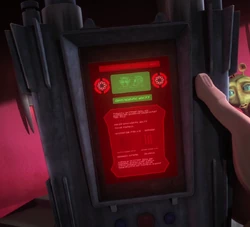 Jin-Rio Akabi's datapad
Datascreens were devices capable of displaying computer information in a graphical format. The technology used to create images on datascreens varied. Similarly, the materials used in their construction also differed considerably. In contrast to three-dimensional Hologram displays, datascreens showed flat graphics or text. Generally, they also had a higher resolution than Hologram displays. Datascreen displays were favored over holograms for a number of reasons. Portable devices like Datapads and Jedi testing screens typically used datascreens instead of holograms, though some offered both. Advertiscreens were frequently placed on city walls and near Hover car routes to present information about commercial products. Datascreens were also preferred on ship bridges to conserve space. It was often possible to fit several datascreens into the space required for a single hologram display.
Jin-Rio Akabi's datapad
Datascreens were devices capable of displaying computer information in a graphical format. The technology used to create images on datascreens varied. Similarly, the materials used in their construction also differed considerably. In contrast to three-dimensional Hologram displays, datascreens showed flat graphics or text. Generally, they also had a higher resolution than Hologram displays. Datascreen displays were favored over holograms for a number of reasons. Portable devices like Datapads and Jedi testing screens typically used datascreens instead of holograms, though some offered both. Advertiscreens were frequently placed on city walls and near Hover car routes to present information about commercial products. Datascreens were also preferred on ship bridges to conserve space. It was often possible to fit several datascreens into the space required for a single hologram display.
 A datascreen displaying a forensics report
The Data screen unit served as a standard measurement for the amount of information a datascreen could show. This was determined by the datascreen's size and resolution. While most datascreens could only be viewed from one angle, some were transparent, similar to windows. These could display information on both the front and back of the screen.
A datascreen displaying a forensics report
The Data screen unit served as a standard measurement for the amount of information a datascreen could show. This was determined by the datascreen's size and resolution. While most datascreens could only be viewed from one angle, some were transparent, similar to windows. These could display information on both the front and back of the screen.
Datacards, which stored specific data like star charts, encyclopedias, travel guides, legal texts, and fictional works, were widely available. These datacards could be loaded into a datapad for convenient access. Many planetary governments were legally required to provide such materials, especially local laws, to all visitors from other planets.
Datapads came in various sizes, ranging from palm-sized devices to larger units designed for two-handed use. A typical datapad was the Companion2000, which weighed under 1 kg and cost around 100 credits. MicroData Technologies produced it, offering a diverse selection of datapad models.
Datapads were crucial as digital notebooks. Revan and the Jedi Exile frequently used their datapads to record notes and store data related to their missions.
Other individuals, such as bounty hunters, also used datapads. Bounty hunters often used datapads to keep mission data about their targets, locations, and other key details. Personal Datapads like these were designed to automatically erase all stored information if mishandled.
In numerous LucasArts games, a datapad interface is displayed on-screen to present the game menu, including inventory, mission objectives, level maps, and other relevant details.
Visual Star Wars media (including comics, movies, and television shows) almost always contain graphical computer displays. They are most often referred to as "datascreens" or "monitors," though they are often unnamed.